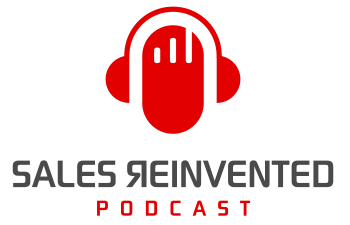
Episode #2 Chase Sutton

Meet
Chase Sutton
Chase Sutton is a Business Development Manager with 15 years of experience at 3M’s Abrasive Systems Division. Based in Wichita, KS, he specializes in managing large multi-location strategic accounts. From developing National Business Agreements to creating rollout plans that support reps in manufacturing facilities across the US and Canada, Chase is the QB for 3M ASD in companies operating in the Heavy Metal Fabrication space. Chase also achieved S-5 in under 10 years at 3M. He has now reached the pinnacle of sales representatives at two Fortune 500 companies (Procter & Gamble- Senior Consultant). Chase graduated with a degree in Marketing from Fort Hays State in Hays, KS. He has been married to Melany for 26 years and is a #GIRLDAD to 2 daughters, Brynn, 17, and Harper, 12. Fun Fact: Chase was the first ever college graduate on both sides of his family.
Our Mission Is To Change The Negative Perception Of Sales People
Our Vision Is A World Where Selling Is A Profession To Be Proud Of
We’re thrilled to have Chase Sutton, a talented Business Development Manager at 3M Abrasive Systems, join us to share his expertise on mastering two key elements of sales strategy: ROI (Return on Investment) and COI (Cost of Inaction).
Chase, who brings 15 years of experience managing major accounts in heavy metal fabrication, shares invaluable insights into why these concepts are essential cornerstones of successful sales conversations. He discusses ensuring prospects fully understand the value offered before price discussions begin. We’re also exploring how sales professionals can effectively calculate and communicate the hidden costs of inaction to their clients.
Chase gives us some real-world examples that illustrate the power of a strong business case and how to handle client objections to ROI and COI calculations. Chase also highlights strategies for forging win-win partnerships and using in-depth knowledge and preparation to navigate the sales landscape.
Outline of This Episode
- [00:00] Mastering ROI and COI in sales conversations.
- [01:21]The fundamental difference between ROI, return on investment, COI, cost of inaction, and why they are crucial in sales conversations.
- [06:09] Research gives you valuable insights, helping highlight the cost of inaction.
- [10:06] Uncover client decision paralysis and motivations to understand and navigate the sales landscape effectively.
- [12:23] Demonstrate value during negotiations, involve customers to highlight inaction costs, and gather insights to push decision-makers’ buttons effectively.
- [16:12] Give customers all the information to highlight what they’re missing, leveraging their fear of missing out to motivate them.
Understanding Return on Investment and Cost of Inaction
Mastering the art of communicating Return on Investment (ROI) and Cost of Inaction (COI) is crucial for closing deals and building lasting customer relationships. In the second episode of the 3M Shaped for Success Series, we’ll explore the nuances of COI and ROI and how sales professionals can effectively integrate them into their strategies.
At the core of successful selling is the ability to convey value. ROI and COI are two sides of the same coin that allow salespeople to paint a complete picture of value to their prospects. Chase explains that ROI helps customers visualize the long-term benefits of their investment, while COI creates a sense of urgency by highlighting the potential losses if they don’t act.
By using ROI, salespeople can align their solutions with the prospect’s long-term goals and show how quickly they can recoup their investment through savings or increased efficiency. COI, on the other hand, emphasizes immediate action by demonstrating what the customer stands to lose. This dual approach engages decision-makers on both logical and emotional levels.
Ensuring Value Outshines Price
One of the standout points from the discussion is the adage that “price is only ever an issue in the absence of value.” According to Chase, asking customers directly about the value that your company has brought them over the past year can open dialogue and reveal insights into how well the value has been demonstrated and received.
Sales professionals need to be proactive in documenting value through cost savings, efficiency improvements, and other metrics. Presenting case studies of similar companies can illustrate the potential benefits, making the ROI and COI calculations tangible.
Quantifying the Cost of Inaction
Effectively quantifying and communicating COI can turn hesitancy into action. Chase suggests that preparing a simple, one-page document highlighting what a customer misses out on, such as labor savings, safety improvements, or increased throughput, can be compelling. The key is to show how these elements add up over time in terms that resonate with the customer, whether it’s on a daily, monthly, or yearly basis.
Building a Strong Business Case
A well-structured business case incorporates both ROI and COI. Chase shares a great example of how he regained a customer’s business by presenting data on what they missed over two years after switching to a competitor. By highlighting operator dissatisfaction and increased usage, he built a compelling business case that the prospect had no choice but to return to 3M.
The process involves laying out the costs and expected savings of making a change, as well as the ticking clock of missed opportunities. Salespeople should ensure prospects can share this information with superiors, gaining internal support for the decision.
Even with a solid business case, customers may hesitate. Understanding the root cause of reluctance is critical. Past experiences or internal politics might influence prospects. Salespeople can uncover these barriers by asking thoughtful questions and presenting real-world examples that show the potential impact.
Top Tips for Sales Success
Toward the end of the podcast, Chase shares his top dos and don’ts when positioning ROI and COI. Highlights include forging personal connections with clients, approaching relationships as partnerships, and maintaining a prepared and confident demeanor. He stresses the importance of relentless preparation and continuous education to ensure successful sales conversations.
Integrating ROI and COI into sales strategies is not just about numbers; it’s also about storytelling and aligning solutions with customer needs. By understanding and articulating the value of action versus inaction, sales professionals can elevate their conversations, build trust, and drive results.
Connect with Chase Sutton
Connect With Paul Watts
Audio Production and Show notes by
PODCAST FAST TRACK
https://www.podcastfasttrack.com
Get to know Chase Sutton
ROI Success Story: Can you share an example of a time when demonstrating ROI helped close a significant deal? What was the key factor?
-
- I had a customer that didn’t want to consolidate all of their quick change buttons to a single streamlined TR button because of the cost of new back up pads. I had a lot to gain in the form of about $350,000 of competitive business through this. I knew that the mechanics had a separate tool for each button. Here are the steps I took:
- Met with the tool crib to find out how many tools get serviced per month and the avg cost per tool repair
- Met with my executive contact to find out how many mechanics use these discs and tools to find out how many tools would be able to be freed up and back in circulation to replace a tool that normally would need to be repaired.
- This was going to give me a lot of mileage and dollars freed up for them to purchase backup pads.
- All in all, I calculated that within just 4 months, they could outfit every mechanic with 2 new backup pads of the new single button type and realize the expense was paid for. They would then go on to realize $520,000 in additional cost savings because of the streamlined approach.
- They saw me as wanting to help them out and streamline their process which gave them the power but I still got what I wanted, an extra $350,000 in new business.
- I had a customer that didn’t want to consolidate all of their quick change buttons to a single streamlined TR button because of the cost of new back up pads. I had a lot to gain in the form of about $350,000 of competitive business through this. I knew that the mechanics had a separate tool for each button. Here are the steps I took:
COI in Action: What’s the most effective way you’ve convinced a customer that the cost of doing nothing was greater than making a change?
-
- I have been able to get every single fact on the table from operator happiness to cost savings calculated to the day to quality repair costs to labor cost savings to reduction of recordable injuries that could have been avoided. Once I have the full story and equity within the organization based on the relationships I have built, I had a strong and irrefutable case that made the pain of not changing so great, they had to change. I had to make them feel the pain of not changing and realize the fear was real enough that the action had to be swift.
Common Pitfalls: What are the biggest mistakes salespeople make when trying to communicate ROI or COI, and how can they avoid them?
-
- Making assumptions. Don’t assume how the customer will react or think or what their motivations are. Make hypotheses and then test them in the meeting by asking questions. Ask a lot of questions to gather verbal and nonverbal responses, and see exactly where they are and what motivates them.
- Making promises on unknowns. You can’t make promises about the outlook for the year ahead without doing your homework prior to the meeting. Have all the facts and triple-check them so that you can put full confidence in your recommendations. Remember, you are the abrasive expert and they are looking to you as the “consultant”
- Don’t make the COI about the customer being wrong; you don’t want to insult them. Instead, you will want to partner with them, looking out for their best interests. Show them the things they are missing out on, both monetarily and in terms of value added. Let them know that you want to partner with them to help them bring these things into their facility and make them a reality.
Essential ROI & COI Questions: What are the top three questions sales reps should ask to uncover a prospect’s true ROI potential and COI risks?
-
- Can you provide an idea of the impact this proposal will have on your business or what success would look like in 3-5 years?
- What issues have hindered your company’s ability to implement new processes or projects in the past?
- What would happen if you didn’t take any action to change the current situation or problem?
Future Trends in Value Selling: How do you see the role of ROI and COI evolving in sales as buyer expectations and economic conditions change?
-
- As technology advances, efficiencies will continue to increase rapidly and improve. Companies will be compelled to continually evaluate better products, processes, and solutions. If they don’t, they will be left behind. So, therefore, ROI and COI become synonymous with each other. They need to evaluate the return on investment (ROI) of a project to ensure it is beneficial to a company’s bottom line. Then, if it is advantageous, and they do nothing about it for whatever reason, COI comes into play. This is where salespeople need to ensure that FOMO is relevant and at the forefront of their minds.
Connect with Chase Sutton
Chase Sutton LinkedIn URL – https://www.linkedin.com/in/chase-sutton-6a478710/
Share This Episode, Choose Your Platform!
